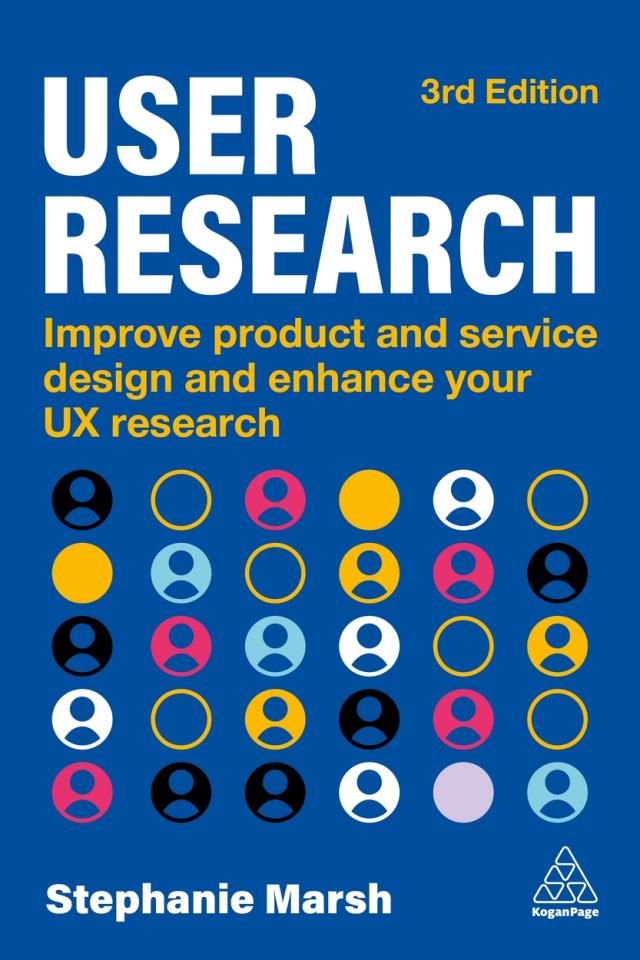Get a FREE ebook with your print copy when you select the "bundle" option. T&Cs apply.
- Shop
- KoganPage+
- Discover
- Resources For...
- Authors
- About
- Shop
- KoganPage+
- Discover
- Resources For...
- Authors
- About

User Research
Improve Product and Service Design and Enhance Your UX Research
Publishing partner
FREE UK and US delivery
Bulk buying for your team?
Contact us for exclusive discounts!
About the book
Many businesses are rooted in creating desirable products and services for users, but fail to consider the consumer. How can they create products and services that work for users? This book has the answers.
User experience research, (UX research) focuses on understanding user behaviours, needs and motivations through a range of observational techniques, task analysis and other methodologies. User Research is a practical guide that shows mid-career professionals and academic readers how to use the vast array of user research methods available. Written by Stephanie Marsh, one of the UK's leading UX research professionals, readers can benefit from in-depth knowledge that explores the fundamentals of user research.
Covering all the key research methods including face-to-face user testing, card sorting, surveys and many more, the book gives expert insight into the nuances, advantages and disadvantages of each. While also providing guidance on how to interpret, analyze and share the data once it has been obtained. Now in its third edition, User Research provides new insight into how to incorporate cross-functional collaboration when approaching user research, how to navigate the ever-changing world of GDPR as AI enters the research space and a pathway to founding their products and services with the understanding of consumer behaviour.
About the authors
Table of contents
- Chapter - 01: Introduction – why is user research so important?;
- Section - ONE: The fundamentals – what good research looks like;
- Chapter - 02: Planning your user research;
- Chapter - 03: Best practice in user research – what, why and how;
- Chapter - 04: Managing user research for successful outcomes;
- Chapter - 05: Getting the legal and ethical stuff right;
- Chapter - 06: Cross-functional working;
- Section - TWO: Selecting and using user research methods;
- Chapter - 07: Usability testing – observing people doing things;
- Chapter - 08: User interviews – understanding people’s experience through talking to them;
- Chapter - 09: Surveys – how to gauge a widespread user response;
- Chapter - 10: Getting the best out of stakeholder workshops – collaborative sessions for constructive work with key participants;
- Chapter - 11: Content testing – what do people think your content means?;
- Chapter - 12: Card sorting – understanding how people group and relate things;
- Chapter - 13: Information architecture validation through tree testing – does the structure of your information work for your users?;
- Chapter - 14: Diary studies – how to capture user research data over time;
- Chapter - 15: Contextual inquiry – interviewing people in their own environment;
- Chapter - 16: Ethnography and pop-up research – observing how people behave and running fast-paced research in the real world;
- Chapter - 17: How to combine user research methodologies;
- Section - THREE: Analysing user research data and communicating the insights;
- Chapter - 18: In-depth analysis – understanding your qualitative data;
- Chapter - 19: Fast-paced analysis;
- Chapter - 20: Analysing usability data and cataloguing issues and needs;
- Chapter - 21: Making recommendations – how to make your research findings and insights actionable;
- Chapter - 22: Creating impactful executive summaries and detailed reports to present results;
- Chapter - 23: Tools for analysis and UX storytelling;
- Chapter - 24: Conclusion;
Reviews
- A complete and exhaustive guide for both new and experienced User Researchers. Stephanie Marsh manages to cover the breadth of researchers' jobs, from selecting appropriate methods to effectively communicating the impact. The chapter about research ethics is particularly useful; it grapples with the unintended consequences of our decision-making which is particularly timely in the age of AI.
- Katie Alden-John, Research and Transformation Leader, Caution Your Blast Ltd
Bulk buying for your team?
Contact us for exclusive discounts!
FREE UK and US delivery
Shipping and handling
Cancellations and returns policy
FREE UK and US delivery (more info)
Kogan Page GPSR
Bulk buying? Contact us for exclusive discounts!
Get exclusive insights and offers
EU Representative (GPSR)
eucomply oÜ
Pärnu mnt. 139b – 14, 11317 Tallinn, Estonia
www.eucompliancepartner.com
Kogan Page GPSR
Related products
Related content
Subscribe for inspiring insights, exclusive previews and special offers
Headless Content Management with Blaze

